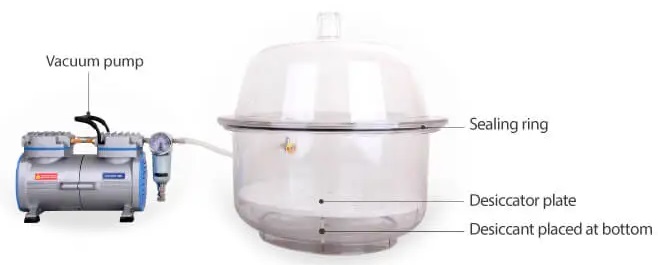What is vacuum drying?
Vacuum drying is a method that removes moisture from a solid sample or air. The principle is to use vacuum to lower the boiling point of moist or solvent, at the same time, molecules diffuse to the surface and evaporate due to low pressure. To accelerate vacuum drying efficiency, heaters are often involved. A vacuum drying chamber with temperature controls is usually known as vacuum oven, for example, Fisher Isotemp Vacuum Oven.
Vacuum drying applications
Samples after vacuum drying are less possible to be contaminated, oxidized or react with water. Make this method often used before storing heat or moisture-sensitive, hygroscopic substances, such as food and chemicals. It’s also very often to see vacuum desiccators used in laboratories to remove trace moisture in experimental samples. In Determination of Moisture in Food (CNS 5033) and Determination of Total Dissolved Solids and Suspended Solids in Water – 103-105℃ (NIEA W 210.58A) regulations, samples should be dried repeatedly in vacuum desiccators to remove trace moisture, then be weighted to determine the moisture content in the sample.
Vacuum drying equipment
Most common laboratory scale vacuum drying equipment and systems include a desiccator and vacuum pump as shown below.

A desiccator generally includes an outer case, relief valve, vacuum connector and a vacuum gauge.
- Outer case: Usually made of acrylic or glass. It’s recommended to apply grease or Vaseline on the glass surface to increase improve seal performance.
- Desiccator plate: To place samples and create chamber at bottom, which is a place for desiccants, such as silica gel, calcium chloride, active charcoal, clay or molecular sieve to accelerate drying.
- Relief valve: To release vacuum.
- Vacuum connector: To be connected with vacuum source/ vacuum pump.
- Vacuum gauge: To observe the vacuum in chamber.
Selecting proper desiccators
For natural substances, you may choose acrylic-made desiccators. For chemicals or solvents, it’s suggested to use glass-made desiccators. Acrylic-made desiccators are in general less pressure-resistance, please use vacuum based on in struction.
Selecting proper pump for vacuum drying
Pumps for vacuum drying should be dependent to the samples’ chemical characteristics and vacuum chamber (desiccator) size. Pump flow rate should be higher for larger desiccators. Flow rate should be 2 times higher than the chamber capacity. Choose pumps with higher vacuum for degassing the samples with higher boiling point or are stickier.
| Samples | Capacity | Flow rate (L/min) | Vacuum (mbar) | Pump recommended |
| Natural substances | < 15 LI.D. < 200 mm | 23 | 30 | Rocker 410 |
| > 15 LI.D. > 200 mm | 60 | 30 | Rocker 810 | |
| Chemicals | < 20 LI.D. < 350 mm | 20 | 10 | Chemker 410/411 |
| 34 | 7 | Chemker 610/611 | ||
| 23 | 25 | Rocker 410C | ||
| 37 | 15 | Rocker 910C |
Literature references
| Literature | Author | Method applied |
| Solvent polarity mediates phytochemical yield and antioxidant capacity of Isatis tinctoria | Abdul Wakeel et al. | Vacuum drying |
Vacuum desiccator and its applications
Vacuum degassing
Vacuum degassing, is a technique of removing dissolved gases from liquids by lowering the pressure in a container with thw solution. It’s very commonly applied in laboratories for defoaming solvents, as well as cosmetic manufacturers for degassing gels and cream.
Container closure integrity testing, CCIT
This method is used to inspect package closure by placing packed sample in a vessel and create vacuum inside, a finely packed sample should retain without any leakage due to the lowered pressure. This method is commonly applied in food & beverage, cosmetics and medicine manufacturing industries as non-destructive packaging inspection.
Appendix: Other Drying Methods
Below introduces some other common drying methods in laboratories.
| Standard Desiccant | Automatic Desiccant Regeneration | Vacuum Desiccant | Gas Purge | |
| Principle | Use desiccants to absorb moisture from air. | Generates continuous processed dry air with fan and heater to maintain low humidity. | Remove air and moisture in a vacuum chamber with pump. | Add dry nitrogen to replace air and moisture |
| Advantage | Large variety selection of desiccants, more economical. | Needs little or no monitoring. | Very low humidity and contact with air. | Achieve low relative humidity faster. |
| Desiccant | Suitable for large variety of desiccants | Silicone | Silicone, active charcoal | Silicone, active charcoal |
| Desiccant consumables | Yes | No | Yes | Yes |
References:
- Container and Closure System Integrity Testing in Lieu of Sterility Testing as a Component of the Stability Protocol for Sterile Products, FDA
- Container Closure Integrity Testing (CCIT), BonfiglioliTM Engineering
- Desiccator, Wikipedia
- Desiccator, fisher scientific
- The Vacuum Decay Method (VDM) and validation, BonfiglioliTM Engineering